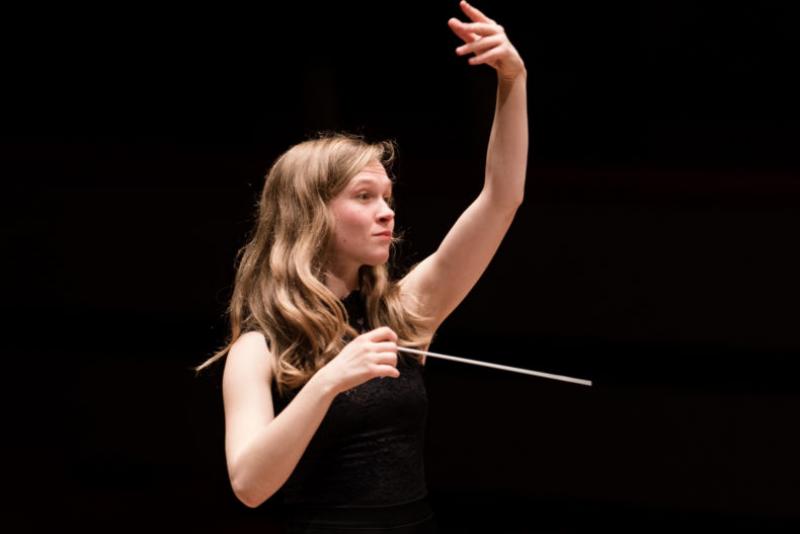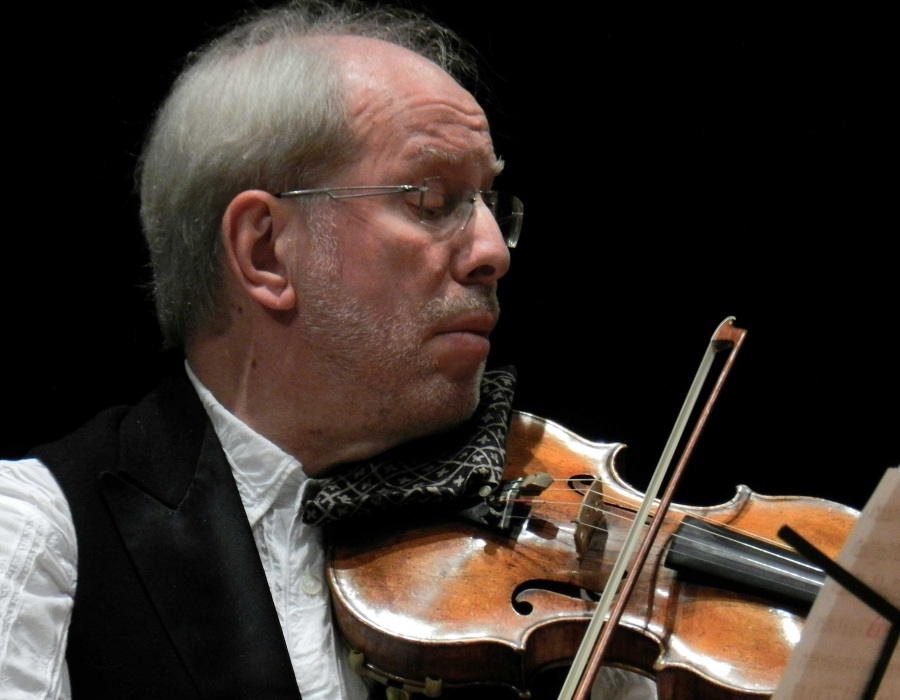CBSO, Kremerata Baltica, Gražinytė-Tyla, Symphony Hall, Birmingham review - numb laments and life after death | reviews, news & interviews
CBSO, Kremerata Baltica, Gražinytė-Tyla, Symphony Hall, Birmingham review - numb laments and life after death
CBSO, Kremerata Baltica, Gražinytė-Tyla, Symphony Hall, Birmingham review - numb laments and life after death
Mirga is back with tough endgame symphonies by Shostakovich and Weinberg

Mirga Gražinytė-Tyla, the City of Birmingham Symphony Orchestra's latest dynamo of a music director and communication incarnate, doesn't believe in taking it easy.
It could have been too much of a grey-black thing. Weinberg's last completed symphony, the 21st of 1989-91, is a lament - "Kaddish" was one mooted title - dedicated "to the victims of the Warsaw ghetto", which included his own family, and it tenaciously refuses to sell out to a light-filled optimism for the future. Shostakovich's symphonic swansong, the 15th, composed entirely in July 1971, arrives at the terror of death after its short first movement - surely encapsulating the composer's suggestion of a life-cycle programme for the entire work whizzed through at daunting speed - but finds an enigmatic A major resolution in one of the most extraordinary and idiosyncratic of all symphonic conclusions. That and the opening movement with its deadpan quotations of Rossini's William Tell galop were just enough to hold on to for relief of sorts.
In any case, Mirga gave us and the orchestra very different body languages for these two epics. Weinberg, uneven as in most of his works but with stretches of genius, is at his least convincing in the big tragic thrashes, but these she controlled with scything, energetic movements, forging a path for the gritty material that was especially impressive in the fierce two-part counterpoint mostly shared between upper and lower strings. Shostakovich's journey she treated as poker-faced fate, starting not with a sense of buoyant galop but of inexorable unfolding, culminating in unearthly beauty.  Integrity is common to both composers, even if Shostakovich works at a consistently higher level of inspiration and originality. Weinberg's skill is not so much in providing a sense of structural inevitability - though he mines a concentrated number of ideas - as in shifting the orchestral colourscapes even in the numb opening Largo, with austere violin solos - taken by 71-year-old Kremer himself (pictured above by Horst Helmut Schmeck), up and behind his colleagues - between full string and later brass threnodies. The orchestral pianist tries out Chopin's First Ballade, symbol of Polish melancholy, but falters; later an uncomically clumsy double bass (Kremerata Baltica's Iurii Gavryluk) initiates the most original sequence, leading to klezmer music for clarinet (the CBSO's Oliver Janes, flawless in Weinberg's extreme writing) that gets torched by full-orchestral blasts.
Integrity is common to both composers, even if Shostakovich works at a consistently higher level of inspiration and originality. Weinberg's skill is not so much in providing a sense of structural inevitability - though he mines a concentrated number of ideas - as in shifting the orchestral colourscapes even in the numb opening Largo, with austere violin solos - taken by 71-year-old Kremer himself (pictured above by Horst Helmut Schmeck), up and behind his colleagues - between full string and later brass threnodies. The orchestral pianist tries out Chopin's First Ballade, symbol of Polish melancholy, but falters; later an uncomically clumsy double bass (Kremerata Baltica's Iurii Gavryluk) initiates the most original sequence, leading to klezmer music for clarinet (the CBSO's Oliver Janes, flawless in Weinberg's extreme writing) that gets torched by full-orchestral blasts.
Holocaust once suggested, Weinberg is not about to let go of the infinite pain felt by the survivor. Superb treble Freddie Jemison - presumably amplified, to great effect - and soprano Maria Makeeva shared the final Kaddish sequence, disrupted by orchestral thuddings. Somehow too austere to be moving, the conclusion will stay in the memory.
As will the extraordinary rareified sounds Mirga drew from her combined violins in the endgame of the Shostakovich: this was ineffably great conducting and music-making. Stern and unyielding in the first movement, trusting simply in the sharp-edged parade of bizarre orchestral juxtapositions and Shostakovich's unique engagement of the "tongs and the bones" - virtuoso xylophone playing in both symphonies - she let the numb atmosphere of the spare Adagio tell in perfectly-placed chords from another planet, eloquent chamber-musical solos from Eduardo Vassallo - the lone voice asking not to be buried just yet - and chillingly faceless brass in the central funeral march.
The spareness only made the harsh unleashing of full forces in the climaxes both here and at the height of the finale's central Passacaglia all the more devastating. But the mortally ill Shostakovich's real gift to eternity are those moments where time becomes space - and never more than in the percussion tattoos of the end, a final stroke of glockenspiel, celesta and triangle telling us, as in a Russian liturgy, that the service is ended just as it began . No show, just profound and dedicated musicianship.
rating
Explore topics
Share this article
The future of Arts Journalism
You can stop theartsdesk.com closing!
We urgently need financing to survive. Our fundraising drive has thus far raised £49,000 but we need to reach £100,000 or we will be forced to close. Please contribute here: https://gofund.me/c3f6033d
And if you can forward this information to anyone who might assist, we’d be grateful.

Subscribe to theartsdesk.com
Thank you for continuing to read our work on theartsdesk.com. For unlimited access to every article in its entirety, including our archive of more than 15,000 pieces, we're asking for £5 per month or £40 per year. We feel it's a very good deal, and hope you do too.
To take a subscription now simply click here.
And if you're looking for that extra gift for a friend or family member, why not treat them to a theartsdesk.com gift subscription?
more Classical music
 Bizet in 150th anniversary year: rich and rare French offerings from Palazzetto Bru Zane
Specialists in French romantic music unveil a treasure trove both live and on disc
Bizet in 150th anniversary year: rich and rare French offerings from Palazzetto Bru Zane
Specialists in French romantic music unveil a treasure trove both live and on disc
 Scottish Chamber Orchestra, Ibragimova, Queen’s Hall, Edinburgh review - rarities, novelties and drumrolls
A pity the SCO didn't pick a better showcase for a shining guest artist
Scottish Chamber Orchestra, Ibragimova, Queen’s Hall, Edinburgh review - rarities, novelties and drumrolls
A pity the SCO didn't pick a better showcase for a shining guest artist
 Kilsby, Parkes, Sinfonia of London, Wilson, Barbican review - string things zing and sing in expert hands
British masterpieces for strings plus other-worldly tenor and horn - and a muscular rarity
Kilsby, Parkes, Sinfonia of London, Wilson, Barbican review - string things zing and sing in expert hands
British masterpieces for strings plus other-worldly tenor and horn - and a muscular rarity
 From Historical to Hip-Hop, Classically Black Music Festival, Kings Place review - a cluster of impressive stars for the future
From quasi-Mozartian elegance to the gritty humour of a kitchen inspection
From Historical to Hip-Hop, Classically Black Music Festival, Kings Place review - a cluster of impressive stars for the future
From quasi-Mozartian elegance to the gritty humour of a kitchen inspection
 Shibe, LSO, Adès, Barbican review - gaudy and glorious new music alongside serene Sibelius
Adès’s passion makes persuasive case for the music he loves, both new and old
Shibe, LSO, Adès, Barbican review - gaudy and glorious new music alongside serene Sibelius
Adès’s passion makes persuasive case for the music he loves, both new and old
 Anja Mittermüller, Richard Fu, Wigmore Hall review - a glorious hall debut
The Austrian mezzo shines - at the age of 22
Anja Mittermüller, Richard Fu, Wigmore Hall review - a glorious hall debut
The Austrian mezzo shines - at the age of 22
 First Person: clarinettist Oliver Pashley on the new horizons of The Hermes Experiment's latest album
Compositions by members of this unusual quartet feature for the first time
First Person: clarinettist Oliver Pashley on the new horizons of The Hermes Experiment's latest album
Compositions by members of this unusual quartet feature for the first time
 Gesualdo Passione, Les Arts Florissants, Amala Dior Company, Barbican review - inspired collaboration excavates the music's humanity
At times it was like watching an anarchic religious procession
Gesualdo Passione, Les Arts Florissants, Amala Dior Company, Barbican review - inspired collaboration excavates the music's humanity
At times it was like watching an anarchic religious procession
 Classical CDs: Camels, concrete and cabaret
An influential American composer's 90th birthday box, plus British piano concertos and a father-and-son duo
Classical CDs: Camels, concrete and cabaret
An influential American composer's 90th birthday box, plus British piano concertos and a father-and-son duo
 Cockerham, Manchester Camerata, Sheen, Martin Harris Centre, Manchester review - re-enacting the dawn of modernism
Two UK premieres added to three miniatures from a seminal event of January 1914
Cockerham, Manchester Camerata, Sheen, Martin Harris Centre, Manchester review - re-enacting the dawn of modernism
Two UK premieres added to three miniatures from a seminal event of January 1914
 Kempf, Brno Philharmonic, Davies, Bridgewater Hall, Manchester review - European tradition meets American jazz
Bouncing Czechs enjoy their Gershwin and Brubeck alongside Janáček and Dvořák
Kempf, Brno Philharmonic, Davies, Bridgewater Hall, Manchester review - European tradition meets American jazz
Bouncing Czechs enjoy their Gershwin and Brubeck alongside Janáček and Dvořák
 Solomon, OAE, Butt, QEH review - daft Biblical whitewashing with great choruses
Even a top soprano and mezzo can’t make this Handel paean wholly convincing
Solomon, OAE, Butt, QEH review - daft Biblical whitewashing with great choruses
Even a top soprano and mezzo can’t make this Handel paean wholly convincing

Add comment